Excerpts from Jim Conrad's
Naturalist Newsletter
from the October 15, 2007 Newsletter issued from Yerba Buena Clinic just outside Pueblo Nuevo Solistahuacan, Chiapas, MÉXICO
about 1740 meters in elevation, ± LAT. 17° 11' 27"N, LONG. -92° 53' 35"W
OCOTE
When I arrived at Yerba Buena the only person left from the old days was the caretaker, Inés, a substantial lady of about 45 who puts me in the mind of the former Chicago Mayor Daley the way she is so loud, so firmly planted and strong minded. She can use and fix a chainsaw and makes a pretty good boss. She doesn't like what Mexican men expect of a woman so she's single, almost unheard of here. When any of her many chickens, turkeys, dogs or cats misbehave she gives them long, very well-reasoned lectures loud enough to hear every word of fifty yards away and when the critters still misbehave she just laughs and lets it slide.
As part of her welcome to me she handed me a machete she'd just sharpened to perfection herself, and a block of ocote (oh-COTE-eh) wood.
The word ocote is used to describe a pine tree or the wood thereof, though the word pino also is used. The word ocote isn't in my Spanish dictionary so maybe it's a Mexican specialty, from a native language.
 That block of ocote wood couldn't have been a more appropriate welcome gift, for Inés knows I like to fix my breakfasts over a campfire, and nothing is better than ocote wood for starting a fire. It ignites easily when you put a flame to it and burns intensely, but more slowly than, say, paper. You can see some ocote wood sliced from the block Inés gave me at the right.
That block of ocote wood couldn't have been a more appropriate welcome gift, for Inés knows I like to fix my breakfasts over a campfire, and nothing is better than ocote wood for starting a fire. It ignites easily when you put a flame to it and burns intensely, but more slowly than, say, paper. You can see some ocote wood sliced from the block Inés gave me at the right.
Notice the wood's large cells and how the wood glistens as if shellacked. The glisten is from dry resin, and that resin burns like crazy. A loopy, black smoke arose from the burning splinter in my fingers, like that when you set oil-soaked rags afire.
On the slopes around where I'm staying there are two pine species. One is called locally Ocote Blanco, or White Pine, and the other is Ocote Colorado, or Red Pine, sometimes also called Ocote Rojo. I think the White Pine is PINUS TENUIFOLIA and the red one is PINUS OOCARPA. The red one provides the best firewood, and it's by far the less common species.
So, the greater the resin content, the better the wood burns, and resin content varies greatly from species to species, between trees of the same species, and even between different parts of the same tree.
In traditional markets here often you can buy neatly tied bundles of pre-cut ocote splinters for starting fires. It would be wasteful to burn entire ocote logs, plus they'd burn too fast and intense. You want a wood fire to last.
In fact, I've heard of some enterprising US folks who've begun selling ocote splinters attractively packaged and for a hefty price in upscale back-to- nature boutiques in the US.